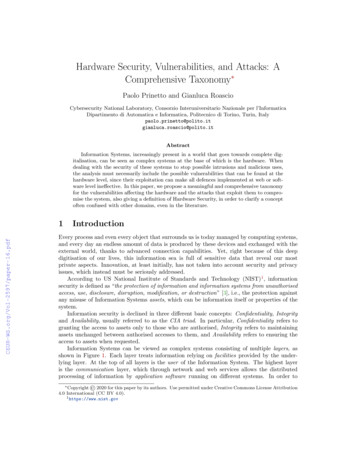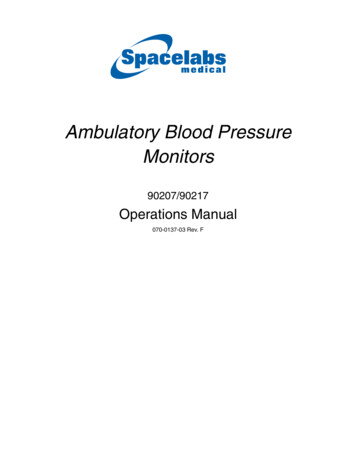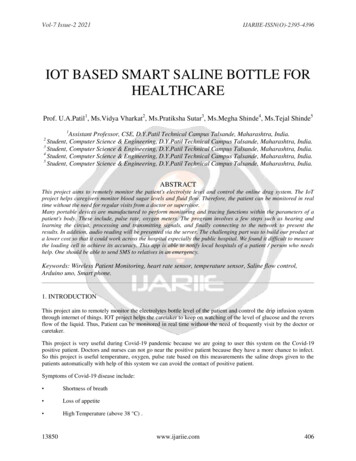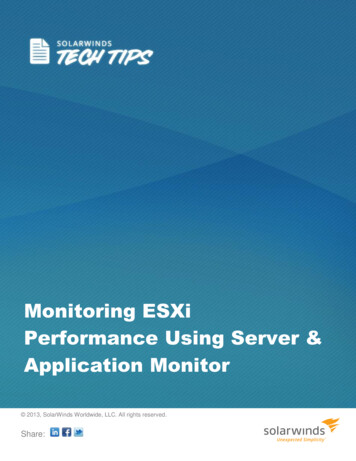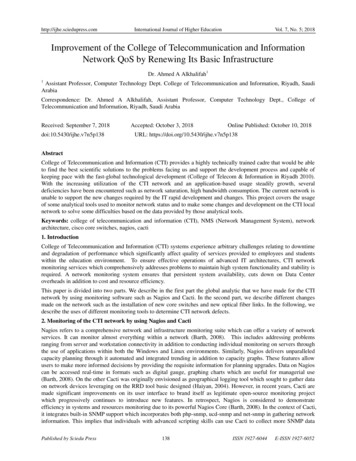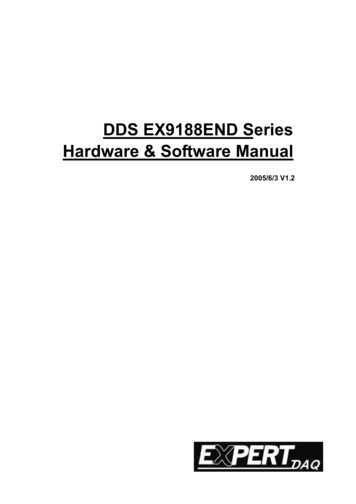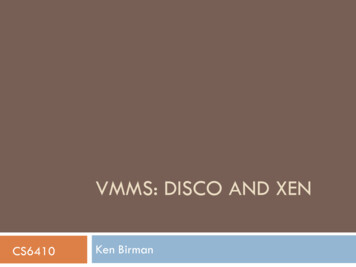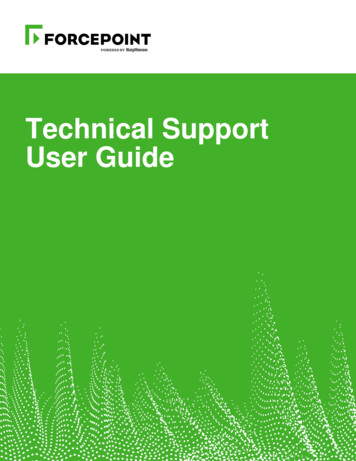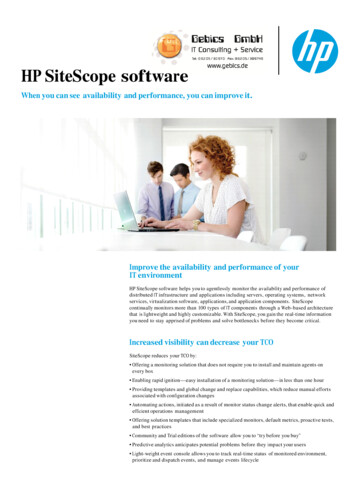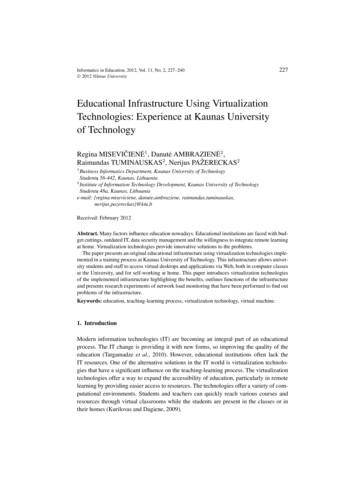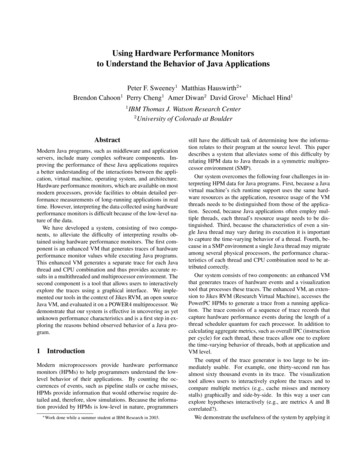
Transcription
Using Hardware Performance Monitorsto Understand the Behavior of Java ApplicationsPeter F. Sweeney1 Matthias Hauswirth2 Brendon Cahoon1 Perry Cheng1 Amer Diwan2 David Grove1 Michael Hind11IBM Thomas J. Watson Research Center2University of Colorado at BoulderAbstractModern Java programs, such as middleware and applicationservers, include many complex software components. Improving the performance of these Java applications requiresa better understanding of the interactions between the application, virtual machine, operating system, and architecture.Hardware performance monitors, which are available on mostmodern processors, provide facilities to obtain detailed performance measurements of long-running applications in realtime. However, interpreting the data collected using hardwareperformance monitors is difficult because of the low-level nature of the data.We have developed a system, consisting of two components, to alleviate the difficulty of interpreting results obtained using hardware performance monitors. The first component is an enhanced VM that generates traces of hardwareperformance monitor values while executing Java programs.This enhanced VM generates a separate trace for each Javathread and CPU combination and thus provides accurate results in a multithreaded and multiprocessor environment. Thesecond component is a tool that allows users to interactivelyexplore the traces using a graphical interface. We implemented our tools in the context of Jikes RVM, an open sourceJava VM, and evaluated it on a POWER4 multiprocessor. Wedemonstrate that our system is effective in uncovering as yetunknown performance characteristics and is a first step in exploring the reasons behind observed behavior of a Java program.1IntroductionModern microprocessors provide hardware performancemonitors (HPMs) to help programmers understand the lowlevel behavior of their applications. By counting the occurrences of events, such as pipeline stalls or cache misses,HPMs provide information that would otherwise require detailed and, therefore, slow simulations. Because the information provided by HPMs is low-level in nature, programmers Workdone while a summer student at IBM Research in 2003.still have the difficult task of determining how the information relates to their program at the source level. This paperdescribes a system that alleviates some of this difficulty byrelating HPM data to Java threads in a symmetric multiprocessor environment (SMP).Our system overcomes the following four challenges in interpreting HPM data for Java programs. First, because a Javavirtual machine’s rich runtime support uses the same hardware resources as the application, resource usage of the VMthreads needs to be distinguished from those of the application. Second, because Java applications often employ multiple threads, each thread’s resource usage needs to be distinguished. Third, because the characteristics of even a single Java thread may vary during its execution it is importantto capture the time-varying behavior of a thread. Fourth, because in a SMP environment a single Java thread may migrateamong several physical processors, the performance characteristics of each thread and CPU combination need to be attributed correctly.Our system consists of two components: an enhanced VMthat generates traces of hardware events and a visualizationtool that processes these traces. The enhanced VM, an extension to Jikes RVM (Research Virtual Machine), accesses thePowerPC HPMs to generate a trace from a running application. The trace consists of a sequence of trace records thatcapture hardware performance events during the length of athread scheduler quantum for each processor. In addition tocalculating aggregate metrics, such as overall IPC (instructionper cycle) for each thread, these traces allow one to explorethe time-varying behavior of threads, both at application andVM level.The output of the trace generator is too large to be immediately usable. For example, one thirty-second run hasalmost sixty thousand events in its trace. The visualizationtool allows users to interactively explore the traces and tocompare multiple metrics (e.g., cache misses and memorystalls) graphically and side-by-side. In this way a user canexplore hypotheses interactively (e.g., are metrics A and Bcorrelated?).We demonstrate the usefulness of the system by applying it
to a variation of the SPECjbb2000benchmark. We show thatthe system is effective in identifying performance anomaliesand also helps us to explore their cause.To summarize, our contributions are as follows: We describe an extension to Jikes RVM to access PowerPC HPMs and accurately attribute them to Java threadsin a SMP environment. Although many prior systems(such as DCPI [5] and OProfile [26]) give users accessto HPMs, we believe ours is the first system that generates Java thread-specific traces over time of HPM datafor multithreaded applications on a multiprocessor. We present the Performance Explorer, a visualization tool for interactively and graphically understanding the data. We use our tools to identify performance anomalies inour benchmark and also to explore the cause of theanomalies. Explaining the cause of the anomalies wastricky due to the complexity of both the software (whichuses hard to understand features such as adaptive compilation and garbage collection) and the hardware (whichemploys an elaborate memory system design). Our visualization tool was invaluable in this exploration, butwe realize that there is still more work to be done in thisarea.The rest of this paper is organized as follows. Section 2provides the background for this work, including an overviewof Jikes RVM and the existing mechanism for accessing thePowerPC HPMs under AIX. Section 3 describes the designand implementation of the VM extension mechanism forrecording HPMs. Section 4 introduces the visualization tool.Section 5 illustrates how the tool can be used to help understand the hardware performance of Java applications. Section 6 discusses related work. Section 7 outlines avenues forfuture work and Section 8 draws some conclusions.2BackgroundThis section provides the background for this work. Section 2.1 provides an overview of the existing Jikes RVM infrastructure that this paper uses as a foundation. Section 2.2summarizes hardware performance monitors on AIX.2.1Jikes RVMJikes RVM [19] is an open source research virtual machinethat provides a flexible testbed for prototyping virtual machine technology. It executes Java bytecodes and runs onthe Linux/IA32, AIX/PowerPC, Linux/PowerPC platforms,and OS X/PowerPC platforms. This section briefly providesbackground on a few relevant aspects of Jikes RVM. Moredetails are available at the project web site [19] and in surveypapers [2, 12, 6].JavaApplicationJVMJavaThread 1JavaThread I 1JavaThread 2.JavaThread IJavaThread I 2Java. . . ThreadMHardware Performance Monitor ExtensionsOperatingSystemOSThread 1OSThread 2.OSThread NPerformance Monitor APIProcessorsProc 1Proc 2Perf CtrPerf Ctr.Proc PPerf CtrFigure 1: Architectural overview.Jikes RVM is implemented in the Java programming language [3] and uses Java threads to implement several subsystems, such as the garbage collector [10] and adaptive optimization system [6]. Thus, our HPM infrastructure providesinsight both into the performance characteristics of Java programs that execute on top of Jikes RVM and into the innerworkings of the virtual machine itself. In particular, by gathering per-Java-thread HPM information the behavior of theseVM threads is separated from application threads. However,VM services, such as memory allocation, that execute as partof the application thread are not separately distinguished.As shown in Figure 1, Jikes RVM’s thread scheduler mapsits M Java threads (application and VM) onto N Pthreads(user level POSIX threads). There is a 1-to-1 mapping fromPthreads to OS kernel threads. A command line argumentto Jikes RVM specifies the number of Pthreads, and corresponding kernel threads, that Jikes RVM creates. The operating system schedules the kernel threads on available processors. Typically Jikes RVM creates a small number of Pthreads(on the order of one per physical processor). Each Pthreadis called a virtual processors because it represents an execution resource that the virtual machine can use to execute Javathreads.To implement M -to-N threading, Jikes RVM uses compiler-supported quasi-preemptive scheduling by having the twocompilers (baseline and optimizing) insert yieldpoints intomethod prologues, epilogues, and loop heads. The yieldpointcode sequence checks a flag on the virtual processor object;if the flag is set, then the yieldpoint invokes Jikes RVM’sthread scheduler. Thus, to force one of the currently executing Java threads to stop running, the system sets this flag andwaits for the thread to execute a yieldpoint sequence. Theflag can be set by a timer interrupt handler (signifying thatthe 10ms scheduling quantum has expired) or by some othersystem service (for example, the need to initiate a garbagecollection) that needs to preempt the Java thread to scheduleone of its own daemon threads. Because yieldpoints are asubset of the GC safe points, i.e., program points where the
stack references (or GC roots) are known, only the runningJava threads need to reach a GC safe point to begin a stopthe-world garbage collection; threads in the scheduler’s readyqueue are already prepared for a garbage collection.2.2AIX Hardware Performance MonitorsMost implementations of modern architectures (e.g. PowerPC POWER4, IA-64 Itanium) provide facilities to counthardware events. Examples of typical events that may becounted include processor cycles, instructions completed, andL1 cache misses. An architecture’s implementation exposes asoftware interface to the event counters through a set of special purpose hardware registers. The software interface enables a programmer to monitor the performance of an application at the architectural level.The AIX 5.1 operating system provides a library with anapplication programming interface to the hardware countersas an operating system kernel extension (pmapi).1 The API,shown as part of the operating system layer in Figure 1,provides a set of system calls to initialize, start, stop, andread the hardware counters. The initialization function enables the programmer to specify a list of predefined eventsto count. The number and list of events depends on the architecture’s implementation, and vary substantially betweendifferent PowerPC implementations (e.g. PowerPC 604e,POWER3, and POWER4). The API provides an interfaceto count the events for a single kernel thread or for a group ofthreads. The library automatically handles hardware counteroverflows and kernel thread context switches.A programmer can count the number of times a hardwareevent occurs in a code segment by manually instrumenting aprogram with the appropriate API calls. Prior to the code segment, the instrumentation calls the API routines to initializethe library to count certain events and to commence counting.After the code segment, the instrumentation calls the API routines to stop counting, read the hardware counter events, andoptionally print the values. The HPM toolkit provides a command line facility to measure the complete execution of anapplication [15].Some processors provide more sophisticated facilities toaccess HPM data. These facilities include thresholding andsampling mechanisms. The thresholding mechanism allowsthe programmer to specify a threshold value and an event.Only if the event exceeds the threshold value is the hardwarecounter incremented. The sampling mechanism allows theprogrammer to specify a value, n, and an event. When theevent occurs for the nth time, the hardware exposes the executing instruction and operand address to the software. ThePOWER4 architecture provides thresholding and samplingcapabilities, but the AIX 5.1 kernel extension library (pmapi)does not support them.1 Thepackage is also available for earlier versions of AIX at IBM’s AlphaWorks site www.alphaworks.ibm.com/tech/pmapi.3VM ExtensionsThis section describes extensions to Jikes RVM that enablethe collection of trace files containing thread-specific, temporally fine-grained HPM data in an SMP environment. Thesection begins by enumerating the design goals for the infrastructure. It then describes the trace record format and highlights some of the key ideas of the implementation. Finally, itconsiders issues that may arise when attempting to implementsimilar functionality in other virtual machines.3.1Design GoalsThere are four primary goals for the HPM tracing infrastructure.Thread-specific data The infrastructure must be able to discriminate between the various Java threads that make upthe application. Many large Java applications are multithreaded, with different threads being assigned differentportions of the overall computation.Fine-grained temporal information The performancecharacteristics of a thread may vary over time. Theinfrastructure must enable the identification of suchchanges.SMP Support The infrastructure must work on SMPs. Inan SMP environment, multiple threads will be executingconcurrently on different physical processors, and thesame Java thread may execute on different processorsover time. There will be a stream of HPM data associated with each virtual processor and it must be possibleto combine these separate streams into a single streamthat accurately reflects the program’s execution.Low overhead Low overhead is desirable both to minimizethe perturbations in the application introduced by gathering the data and to enable it to be used to gather tracesin production environments or for long-running applications.3.2Trace FilesWhen the infrastructure is enabled, it generates a trace filefor each Jikes RVM virtual processor, and one meta file. Thissection describes the structure of the trace and meta files, anddiscusses how the data gathered enables the system to meetthe design goals enumerated in Section 3.1.The core of the trace file is a series of trace records. Eachtrace record represents a measurement period in which exactly one Java thread was executing on the given virtual processor. The HPM counters are read at the beginning and endof the measurement period and the change in the counter values is reported in the trace record. A trace record contains thefollowing data:
Virtual Processor ID This field contains the unique ID ofthe virtual processor that was executing during the measurement period. Although this information can be inferred (each trace file contains trace records from exactly one virtual processor), we chose to encode this inthe trace record to simplify merging multiple trace filesinto a single file that represents an SMP execution trace.Thread ID This field contains the unique ID of the threadthat was executing during the measurement period.Thread Yield Status This boolean field captures if thethread yielded before its scheduling quantum expired. Itis implemented by negating the thread ID.Top Method ID This field contains the unique ID of the topmethod on the runtime stack at the end of the measurement period, excluding the scheduler method taking thesample. Because the complete stack is available, thisfield could be extended to capture more methods as wasdone to guide profile-directed inlining [18].Real Time This field contains the value of the PowerPC timebase register at the beginning of the measurement period represented by this trace record. The time base register contains a 64-bit unsigned quantity that is incremented periodically (at an implementation-defined interval) [22].Real Time Duration This field contains the duration of themeasurement period as measured by the difference in thetime base register between the start and end of the measurement period.Hardware Counter Values These fields contain the changein each hardware counter value during the measurementperiod. The number of hardware counters varies amongdifferent implementations of the PowerPC architecture.In most anticipated uses, one of the counters will becounting cycles executed, but this is not required by theinfrastructure.As each trace record contains hardware counter values for asingle Java thread on a single virtual processor, we are able togather thread-specific HPM data. The key element for SMPsupport is the inclusion in the trace record of the real time values read from the PowerPC time base register. The primaryuse of the real time value is to merge together multiple tracefiles by sorting the trace records in the combined trace by thereal time values to create a single trace that accurately models concurrent events on multiple processors. A secondaryuse of this data is to detect that the OS has scheduled otherPthreads on the processor during the measurement interval.Large discrepancies between the real time delta and the executed cycles as reported by the hardware counter indicatethat some OS scheduling activity has occurred and that thePthread shared the processor during the measurement period.Recall that the OS extension already distinguishes countersfor each OS kernel thread.In addition to trace records containing hardware countervalues, a trace file may also contain marker records. We provide a mechanism, via calls to the VM, for a Java threadto specify program points that when executed will place amarker record in the trace file. These marker trace records,which can contain an arbitrary string, allow the programmerto focus on particular portions of an execution’s trace. Because this mechanism is available at the Java level, it can beused to filter both application and VM activities, such as thevarious stages of garbage collection.A meta file is generated in conjunction with a benchmark’strace files. The meta file specifies the number of HPM countervalues in each trace record and provides the following mappings: from counter to event name, from thread ID to threadname, and from method ID to method signature. The numberof counters and the mappings provide a mechanism to interpret a trace record, reducing a trace record’s size by eliminating the need to name trace record items in each individualtrace record.3.3Implementation DetailsTo enable Jikes RVM to access the C pmapi API we defined aJava class with a set of native methods that mirrors the functionality of the pmapi interface, represented by the dashedbox of the JVM in Figure 1. In addition to enabling our VMextensions in Jikes RVM to access these functions, the interface class can also be used to manually instrument arbitraryJava applications to gather aggregate HPM data. We are using this facility to compare the performance characteristics ofJava applications when run on Jikes RVM and on other JVMs.The main extension point in Jikes RVM was to add codein the thread scheduler’s context switching sequence to readthe hardware counters and real time clock on every contextswitch in the VM. This information is accumulated into summaries for each virtual processor and Java thread, and written into a per virtual processor trace record buffer. Each virtual processor has two dedicated 4K trace record buffers anda dedicated Java thread, called a trace writer thread, whosefunction is to transfer the contents of a full buffer to a file.Trace records for a virtual processor are written into an activebuffer. When the buffer is full, the virtual processor signalsthe trace write thread and starts writing to the other buffer.By alternating between two buffers, we continuouslygather trace records with low overhead. By having a dedicated Java thread drain a full buffer, and thus, not suspendthe current thread to perform this task, we avoid directly perturbing the behavior of the other threads in the system. Thisimplementation also enables easy measurement of the overhead of writing the trace file because HPM data is gatheredfor all Java threads, including the threads that are writing thetrace files. In our experiments 1.7% of all cycles are spent executing the trace writer threads. The overhead of reading thehardware counters and real time clock on every thread switch
and storing the trace information into the buffer is in the measurement noise. Thus, the total overhead of the infrastructureis less than 2%.Minor changes were also made in the boot sequence ofthe virtual machine, and in the code that creates virtualprocessors and Java threads to appropriately initialize datastructures. The VM extensions have been available in JikesRVM [19] since the 2.2.2 release (June 2003).The disk space required to store trace records is a function of the trace record size, the frequency of thread switches,and the number of virtual processors. For example, runningone warehouse in the SPECjbb2000 benchmark on one virtual processor, we found that 12 Kbytes per second were written with a 10 millisecond scheduling quantum.3.4DiscussionJikes RVM’s M -to-N threading required an extension of thevirtual machine to gather Java thread specific HPM data. InJVMs that directly map Java threads to Pthreads, it should bepossible to gather aggregate Java thread specific HPM datausing the pmapi library by making relatively simple extensions to read HPM counters when threads are created andterminated. So, in this respect the Jikes RVM implementation was more complex than it might have been in otherJVMs. However, M -to-N threading made the gathering offine-grained temporal HPM data fairly straightforward. Arelatively simple extension to the context-switching sequenceto read the HPM counters on every thread switch was sufficient to collect the desired data. Gathering this kind of dataon virtual machines that do not employ M -to-N threadingwill probably be significantly more difficult because applying a similar design would require modifications to either thePthread or OS thread libraries.4Visualization ToolThis section describes our visualization tool, called the Performance Explorer, which supports performance analysis through the interactive visualization of trace records thatare generated by the VM extensions described in Section 3.Figure 2 presents an overview of the Performance Explorer when run with a variant of SPECjbb2000 using onewarehouse on one virtual processor. The figure comprisesthree parts (a, b, and c), which are further described below.The Performance Explorer is based on two keyconcepts: trace record sets and metrics. A trace record setis a set of trace records. Given the trace files of an application’s execution, the Performance Explorer providesan initial trace record set containing all trace records of allthreads on all virtual processors. It also provides filters tocreate subsets of a trace record set (e.g., all trace recordsof the MainThread, all trace records longer than 5 ms, alltrace records with more than 1000 L1 D-cache misses, or alltrace records ending in a Java method matching the regularexpression “.*lock.*”). Part a of Figure 2 illustrates theuser interface for configuring these filters. Furthermore, thePerformance Explorer provides set operations (union,intersection, difference) on trace record sets.A metric extracts or computes a value from a trace record.The Performance Explorer provides a metric for eachhardware counter gathered in the trace files, and a metricfor the trace record duration. The user can define new metrics using arithmetic operations on existing metrics. For example, instructions per cycle (IPC) can be computed usinga computed metric that divides the instructions completed(INST CMPL) event value by the cycles (CYC) event value.Part b in Figure 2 shows a graph for just one metric. Thehorizontal axis is wall-clock time, and the vertical axis is defined by the metric, which in this case is IPC. The verticalline that is a quarter of the way in from the left side of thegraph represents a marker trace record generated by manualinstrumentation of the program. This specific marker showswhen the warehouse application thread starts executing. Tothe right of the marker, the applications enters a steady statewhere the warehouse thread is created and executed. To theleft of the marker represents the program’s start up where itsmain thread dominates execution. Each line segment in thegraph (in this zoomed-out view of the graph most line segments appear as points) represents a trace record. The lengthof the line segment represents its wall clock duration. Thecolor of the line segment (different shades of gray in this paper) indicates the corresponding Java thread. The user canzoom in and out and scroll the graph.Part c of Figure 2 displays a table of the trace records visualized in the graph, one trace record per line. This tablepresents all the attributes of a trace record, including the values of all metrics plotted in the graph. Selecting a range oftrace records in the graph selects the same records in the table, and vice versa. This allows the user to select anomalouspatterns in the graph, for example the drop in IPC before eachgarbage collection, and immediately see all the attributes (likemethod names) of the corresponding trace records in the tracerecord table. The user can get simple descriptive statistics(sum, minimum, maximum, average, standard deviation, andmean delta) over the selected trace records for all metrics. Finally, a selection of trace records can be named and saved asa new trace record set.In addition to providing time graphs and trace record tables, the Performance Explorer also provides severalother ways to visualize the trace data. The PerformanceExplorer provides thread timelines, which are tableswhere each column represents a thread, each row representsan interval in time, and the cells are colored based on theprocessor that is executing the thread. The PerformanceExplorer provides processor timelines, where each column represents a processor, and the cells are colored based onthe thread that executes on the processor. Cells in these timelines visualize a given metric (like IPC), and they are adornedwith glyphs to show preemption or yielding of a thread at the
Figure 2: Overview of the Performance Explorer.end of a time slice. These timelines are helpful in analyzingscheduling effects. The Performance Explorer provides scatter plots, where the X and Y axes can be any givenmetric, and all trace records of a trace record set are represented as points. Lastly, the Performance Explorercalculates the correlations between any two metrics over atrace record set.Due to the extensive number of HPM events that can becounted on POWER4 processors, and the limitation of a givenevent being available only in a limited number of hardwarecounters, the Performance Explorer provides functionality for exploring the available events and event groups.Because of space considerations, subsequent figures onlycontain information from the Performance Explorerthat is pertinent to the discussion at hand.5 ExperimentsThis section demonstrates how we used the PerformanceExplorer to understand the performance behavior of a variant of the SPECjbb2000 benchmark on a PowerPC POWER4machine.CachesL1 Instr.L1 DataL2 UnifiedL3 localL3 remoteSize32KB64KB1.5MB32MB32MBLine size128B128B128B512B512BKinddirect mapped2-way set assoc.8-way set assoc.8-way set assoc.8-way set assoc.Table 1: POWER4 three levels of cache hierarchy.5.1POWER4The POWER4 [8] is a 64-bit microprocessor that contains twoprocessors on each chip. Four chips can be arranged on amodule to form an 8-way machine, and four modules can becombined to form a 32-way machine. The POWER4 containsthree cache levels as described in Table 1. There is one L1data and one L1 instruction cache for each core on a chip.The L1 caches are store through (write through); that is, awrite to the L1 is stored through to L2. Two processors on achip share an L2 cache. The L2 cache is inclusive of the twoL1 data caches, but not inclusive of the two L1 instructioncaches; that is, any data in the L1 data cache also resides in
the L2 cache. However, data may reside in the L1 instructioncache that does not reside in the L2 cache. The L2 cache isstore in (write back); that is, a write to L2 is not written tomain memory (or L3). Up to four L3 caches can be arrangedon a module. The L3 cache acts as a victim cache, storingcache lines that are evicted from L2; therefore, the L3 cacheis not inclusive of the L2 cache.5.2Experimental MethodologyWe used a 4-way POWER4 machine with two chips in whicheach chip is placed on a separate module. We use a variant of the SPECjbb2000 [29] benchmark for our experiments.SPECjbb2000 simulates a wholesale company whose execution consists of two stages. During startup, the main threadsets up and starts a number of warehouse threads. During steady state, the warehouse threads execute transactionsagainst a database (represented as in-memory binary trees).The variant of SPECjbb2000 that we use is called pseudojbb:pseudojbb runs for a fixed number of transactions (120,000)instead of a fixed amount of time. We run pseudojbb with onewarehouse thread on a single virtual processor. In our configuration, the pseudojbb run takes 25 seconds on a POWER4workstation. We use an adaptive Jikes RVM configurationthat has the adaptive optimization system (AOS) with a semispace garbage collector. The source code for Jikes RVM isfrom the September 26, 2003 head of the public CVS repository.When run on a single virtual processor, Jikes RVM creates eight Java threads during execution in addition to thetwo Java threads created by pseudojbb: a garbage collectionthread that executes only during garbage collection; a finalizer thread that finalizes dead objects and is executed infrequently; a debugger thread that never executes; and an idlethread that helps load balance Java threads when a virtualprocessor is idle, but because only a single virtual processor is used the idle thread never executes. As mentioned inSection 3 t
relating HPM data to Java threads in a symmetric multipro-cessor environment (SMP). Our system overcomes the following four challenges in in-terpreting HPM data for Java programs. First, because a Java virtual machine's rich runtime support uses the same hard-ware resources as the application, resource usage of the VM

